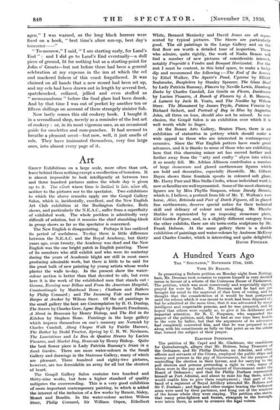Art
GROUP Exhibitions on a large scale, more often than not, leave behind them nothing except a recollection of boredom. It is almost impossible to look intelligently at between two and three hundred pictures unless the whole day is given up to it. The ei7ort where time is limilet: is car, Mier all, neither to the pictures nor to the spectator. Two exhibitions to which the above remarks apply are the Goupil Gallery Salon, which is, incidentally, excellent, and the New English Art Club exhibition at the Burlington Galleries. Both shows, and particularly the N.E.A.C., suffer from a superfluity of exhibited work. The whole problem is admittedly very difficult of solution, but it remains the chief stumbling-block in group shows as far as the spectator is concerned.
The New English is disappointing. Perhaps it has outlived its period of usefulness. To-day there is little difference between the N.EA.C. and the Royal Academy, but thirty years ago, even twenty, the Academy was dead and the New English was the one bright patch in English painting. Those of its members who still exhibit and who were its mainstay during the years of Academic blight are still in most cases producing admirable work, but there is little to be said for the great bulk of new painting by young artists whose works plaster the walls to-day. In the present show the water- colour section is better than that devoted to oils, but even here it is the work of the established men that stands out : Gerona, Evening near Bilbao and From the American Hospital, Constantinople by Muirhead Bone ; Chatham and Bathers by Philip Connard ; and The Incoming Tide and Thames Barges at Anchor by Wilson Steer. Of the oil paintings in the small gallery the best are Contemplation by R. 0. Dunlop, The Severn by Charles Gore, Lyme Regis by Barnett Freedman, A Street in Beauvais by Henry Bishop, and The Bed in the Kitchen by Stephen Bone. Paintings in the large gallery which impress themselves on one's memory are Norwich by Charles Cundall, Along Cheyne Walk by Fairlie Harmer, The Bather by Dodd Proctor, Spring by C. R. W. Nevinson, The Lauristinus and Le Bau de Quatres Hewes by Lucien Pissarro, and Market Day, Beauvais by Henry Bishop. Quite the best flower piece is Lady Patricia Ramsay's Irises in a Sunk Garden. There are more water-colours in the Small Gallery and drawings in the Staircase Gallery, many of which are pleasant. Three hundred and eighty-two pictures, however, arc too formidable an array for all but the stoutest of heart.
The Goupil Gallery Salon contains two hundred and thirty-nine works, but here a higher standard of quality mitigates the overcrowding. This is a very good exhibition of more important contemporary painting, to which is added the interest of the inclusion of a few works by Renoir, Sisley, Monet and Boudin. In the water-colour section Wilson Steer, Philip Connard, Sir William Orpen, Ethelbert
White, Bernard Meninsky and David Jones are all repre- sented by typical pictures. The Steers are particularly good. The oil paintings in the Large Gallery and on the first floor are worth a detailed tour of inspection. Those who admire, quite rightly, the work of Nadia Bersois will find a number of new pictures of considerable interest, notably Proprie:te a Vendre and Bouquet Horizontal. For the red I must be content, in this brief space, to make a lucky dip and recommend the following :—The End of the Season by Ethel Walker, The Squire's Pond, Upcerne by Elliott Seabrooke, Burghelere by Stanley Spencer, The Glass Bout by Lady Patricia Ramsay, FigiVeT8 by Neville Lewis, Hamburg Docks by Charles Cundall, Les Geniis en Pleurs, Dardennes by Lucien Pissarro, A Bunch of Flowers by J. B. Manson, A Lament by Jack B. Yeats, and The Needles by Wilson Steer. The Monument by James Pryde, Pulana Venezia by Richard Sickest, and Portrait of Boy in Blue by Augustus John, all three on loan, should also not be missed. In con- clusion, the Goupil Salon is an exhibition over which it is well worth while to linger.
At the Beaux Arts Gallery, Bruton Place, there is an exhibition of statuettes in pottery which should make a wide appeal to those who are interested in contemporary ceramics. Since the War English potters have made great advances, and it is thanks to some of those who are exhibiting here that this charming minor art has moved farther and farther away from the "arty and crafty" abyss into which it so nearly fell. Mr. Adrian Allinson contributes a number of large stoneware and glazed earthenware figures which are bold and decorative, especially Hornbills. Mr. Gilbert Reyes shows three fountain spouts in coloured salt glaze. Mr. Harry Parr and Miss Stella Crofts, whose individual work i3 now so familiar are well represented. Some of the most charming figures are by Miss Phyllis Simpson, whose Dandy Dennis, which is, I believe, a portrait from life of Mr. T. Walton's race horse, Alice, Betsinda and Pair of Dutch Figures, all in glazed fine earthenware, deserve special notice for their technical skill and delicacy of colour and modelling. Mr. Phoebe Stabler is represented by an imposing stoneware piece, Girl Garden Figure, and, in a slightly different category from the other exhibits, there are six terra-cotta sculptures by Mr. Frank Dobson. At the same gallery there is a double exhibition of paintings and water-colours by Ambrose McEvoy and Charles Conder, which is interesting and quite delightful.
DAVID FINCHAM.










































 Previous page
Previous page